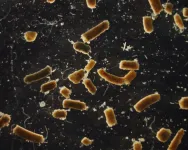(Press-News.org) Since Wilhelm Röntgen discovered them in 1895, X-rays have become a staple of medical imaging. In fact, barely a month after Röntgen's famous paper was published, doctors in Connecticut took the first ever radiograph of a boy's broken wrist.
There has been a lot of progress since. Aside from radiographs, which most people have taken at least once in their lives, today's X-ray medical uses includes fluoroscopy, radiotherapy for cancer, and computer tomography (CT), which takes multiple X-ray scans of the body from different angles and then combines them in a computer to generate virtual cross-sectional "slices" of a body.
Nonetheless, medical imaging often works with low-exposure conditions, and therefore requires cost-effective, high-resolution detectors that can operate at what is called a "low photon flux". Photon flux simply describes how many photons hit the detector at a given time and determines the number of electrons it generates in turn.
Now, scientists led by László Forró at the School of Basic Sciences have developed exactly such a device unit. By using used 3D aerosol jet-printing they developed a novel method for producing highly efficient X-ray detectors that can be easily integrated into standard microelectronics to considerably improve the performance of medical imaging devices.
The new detectors are made up by graphene and perovskites, which are materials made up of organic compounds bound to a metal. They are versatile, easy to synthesize, and are at the forefront of a wide range of applications, including in solar cells, LED lights, lasers, and photodetectors.
Aerosol jet-printing is fairly new, and is used to make 3D-printed electronic components like resistors, capacitors, antennas, sensors, and thin-film transistors or even print electronics on a particular substrate, like the case of cell phone.
Using the aerosol jet printing device at CSEM in Neuchatel, the researchers 3D-printed perovskite layers on a graphene substrate. The idea is that, in a device, the perovskite acts as the photon detector and electron discharger while the graphene amplifies the outgoing electrical signal.
The research team used the methylammonium lead iodide perovskite (MAPbI3), which has recently attracted a lot of attention because of its fascinating optoelectronic properties, which pair well with its low fabrication cost. "This perovskite has heavy atoms, which provide a high scattering cross-section for photons, and makes this material a perfect candidate for X-ray detection," says Endre Horváth, the research team's chemist.
The results were stunning. The method produced X-ray detectors with a record sensitivity and a four-fold improvement on the best-in-class medical imaging devices.
"By using photovoltaic perovskites with graphene, the response to X-rays has increased tremendously," says Forró. "This means that if we would use these modules in X-ray imaging, the required X-ray dose for forming an image could be decreased by more than a thousand times, decreasing the health hazard of this high-energy ionizing radiation to humans."
Another advantage of the perovskite-graphene detector is that it is simple to form images using it. "It doesn't need sophisticated photomultipliers or complex electronics," says Forró. "This could be a real advantage for developing countries."
INFORMATION:
The study is published in ACS Nano.
The international research collaboration involving the research team led by evolutionary biologist Professor Axel Meyer at the University of Konstanz and researchers from China and Singapore was able to identify factors that led to the success of the seahorse from a developmental biology perspective: its quickness to adapt by, for example, repeatedly evolving spines in the skin and its fast genetic rates of evolution. The results will be published on 17 February 2021 in Nature Communications.
Seahorses of the genus Hippocampus emerged about 25 million years ago in the Indo-Pacific region from pipefish, ...
COLUMBUS, Ohio - Though Ohio never formally enacted a so-called "heartbeat bill" banning abortions after six weeks of gestation, legislative and legal actions appear to have fueled beliefs that abortion is illegal in the state, a new study has found.
One in 10 Ohio women surveyed for the study thought abortion was prohibited. The percentage with that belief increased from 5% to 16% during the study period, corresponding to sustained activity to limit abortions from fall of 2018 through summer of 2019. The study appears in the American Journal of Obstetrics and Gynecology.
Maria Gallo, the study's lead author and a professor of epidemiology at The Ohio State University, said repeated legislative attempts at extreme restrictions on abortion, the veto by ...
In Switzerland and other European countries, drug prices are regulated to ensure affordable access to drugs. In the last few years, many European countries have introduced rebate schemes for drugs. In most cases, however, the rebates negotiated with the manufacturer are confidential. This means that a country basically has two prices for a drug: an official, higher price and an actual, lower price. Price comparisons of drugs between countries is frequently based on the higher price. Switzerland too has introduced such rebates, which are often confidential, and plans to anchor this practice in the regulation. The Federal Social ...
Scientists have little understanding of the role fishes play in the global carbon cycle linked to climate change, but a Rutgers-led study found that carbon in feces, respiration and other excretions from fishes - roughly 1.65 billion tons annually - make up about 16 percent of the total carbon that sinks below the ocean's upper layers.
Better data on this key part of the Earth's biological pump will help scientists understand the impact of climate change and seafood harvesting on the role of fishes in carbon flux, according to the study - the first of its kind - in the journal Limnology and Oceanography. Carbon flux means the movement of carbon in the ocean, including from the surface to the deep sea - the focus of this study.
"Our study is the first to review ...
Robotic clothing that is entirely soft and could help people to move more easily is a step closer to reality thanks to the development of a new flexible and lightweight power system for soft robotics.
The discovery by a team at the University of Bristol could pave the way for wearable assist devices for people with disabilities and people suffering from age-related muscle degeneration. The study is published today [17 February] in Science Robotics.
Soft robots are made from compliant materials that can stretch and twist. These materials can be made into artificial muscles that contract when air is pumped into them. The softness of these muscles makes then suited to powering assistive clothing. Until now, however, these ...
CHAMPAIGN, Ill. -- Scientists used accelerometers to track daily activity levels for a week in 89 adults with obesity or overweight and, in a series of tests, measured their ability to multitask and maintain their attention despite distractions. The study revealed that individuals who spent more sedentary time in bouts lasting 20 minutes or more were less able to overcome distractions.
Reported in the International Journal of Obesity, the research adds to the evidence linking sedentary behaviors and cognition, said University of Illinois Urbana-Champaign kinesiology and ...
Escherichia coli bacteria are constitutive members of the human gut microbiota. However, some strains produce a genotoxin called colibactin, which is implicated in the development of colorectal cancer. While it has been shown that colibactin leaves very specific changes in the DNA of host cells that can be detected in colorectal cancer cells, such cancers take many years to develop, leaving the actual process by which a normal cell becomes cancerous obscure. The group of Thomas F. Meyer at the Max Planck Institute for Infection Biology in Berlin together with their collaborators have now been able to "catch colibactin in the act" of inducing genetic changes that are characteristic of colorectal cancer cells and cause a transformed ...
Scientists at Columbia University Mailman School of Public Health developed a method using a DNA biomarker to easily screen pregnant women for harmful prenatal environmental contaminants like air pollution linked to childhood illness and developmental disorders. This approach has the potential to prevent childhood developmental disorders and chronic illness through the early identification of children at risk.
While environmental factors--including air pollutants--have previously been associated with DNA markers, no studies to date have used DNA markers to flag environmental exposures in children. Study results are published ...
Women who received physical therapy after undergoing a cesarean section had significantly improved outcomes compared to those who did not according to a new study from University of Missouri Health Care.
"C-section is one of the most commonly performed inpatient procedures, and women who require C-section instead of a spontaneous vaginal delivery are at least twice as likely to suffer low back and pelvic pain," said study author Jennifer Stone, DPT, of MU Health Care's Mizzou Therapy Services. "Our goal was to evaluate the impact of comprehensive physical therapy on recovery following a cesarean birth."
Stone's study recruited 72 women who delivered by cesarean section ...
Preparing regular concrete scientists replaced ordinary water with water concentrate of bacteria Bacillus cohnii, which survived in the pores of cement stone. The cured concrete was tested for compression until it cracked, then researchers observed how the bacteria fixed the gaps restoring the strength of the concrete. The engineers of the Polytechnic Institute of Far Eastern Federal University (FEFU), together with colleagues from Russia, India, and Saudi Arabia, reported the results in Sustainability journal.
During the experiment, bacteria activated when gained access to oxygen and moisture, which occurred after the concrete cracked under the pressure of the setup. The "awakened" bacteria completely repaired fissures with a width ...





